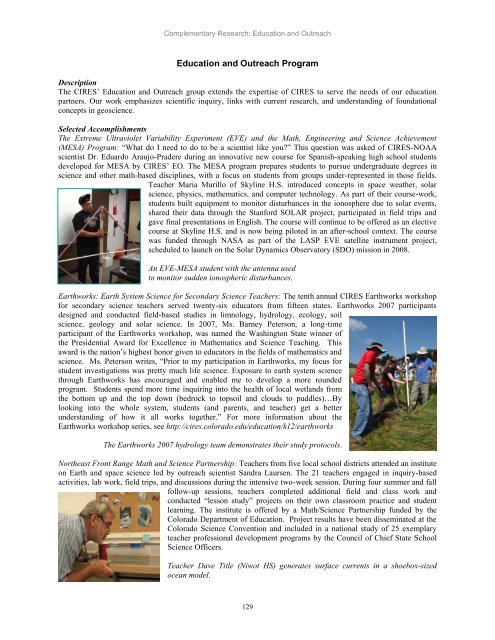Scientific Theme: Advanced Modeling and Observing Systems
Scientific Theme: Advanced Modeling and Observing Systems
Scientific Theme: Advanced Modeling and Observing Systems
You also want an ePaper? Increase the reach of your titles
YUMPU automatically turns print PDFs into web optimized ePapers that Google loves.
Complementary Research: Education <strong>and</strong> Outreach<br />
Education <strong>and</strong> Outreach Program<br />
Description<br />
The CIRES‘ Education <strong>and</strong> Outreach group extends the expertise of CIRES to serve the needs of our education<br />
partners. Our work emphasizes scientific inquiry, links with current research, <strong>and</strong> underst<strong>and</strong>ing of foundational<br />
concepts in geoscience.<br />
Selected Accomplishments<br />
The Extreme Ultraviolet Variability Experiment (EVE) <strong>and</strong> the Math, Engineering <strong>and</strong> Science Achievement<br />
(MESA) Program: ―What do I need to do to be a scientist like you?‖ This question was asked of CIRES-NOAA<br />
scientist Dr. Eduardo Araujo-Pradere during an innovative new course for Spanish-speaking high school students<br />
developed for MESA by CIRES‘ EO. The MESA program prepares students to pursue undergraduate degrees in<br />
science <strong>and</strong> other math-based disciplines, with a focus on students from groups under-represented in those fields.<br />
Teacher Maria Murillo of Skyline H.S. introduced concepts in space weather, solar<br />
science, physics, mathematics, <strong>and</strong> computer technology. As part of their course-work,<br />
students built equipment to monitor disturbances in the ionosphere due to solar events,<br />
shared their data through the Stanford SOLAR project, participated in field trips <strong>and</strong><br />
gave final presentations in English. The course will continue to be offered as an elective<br />
course at Skyline H.S. <strong>and</strong> is now being piloted in an after-school context. The course<br />
was funded through NASA as part of the LASP EVE satellite instrument project,<br />
scheduled to launch on the Solar Dynamics Observatory (SDO) mission in 2008.<br />
An EVE-MESA student with the antenna used<br />
to monitor sudden ionospheric disturbances.<br />
Earthworks: Earth System Science for Secondary Science Teachers: The tenth annual CIRES Earthworks workshop<br />
for secondary science teachers served twenty-six educators from fifteen states. Earthworks 2007 participants<br />
designed <strong>and</strong> conducted field-based studies in limnology, hydrology, ecology, soil<br />
science, geology <strong>and</strong> solar science. In 2007, Ms. Barney Peterson, a long-time<br />
participant of the Earthworks workshop, was named the Washington State winner of<br />
the Presidential Award for Excellence in Mathematics <strong>and</strong> Science Teaching. This<br />
award is the nation‘s highest honor given to educators in the fields of mathematics <strong>and</strong><br />
science. Ms. Peterson writes, ―Prior to my participation in Earthworks, my focus for<br />
student investigations was pretty much life science. Exposure to earth system science<br />
through Earthworks has encouraged <strong>and</strong> enabled me to develop a more rounded<br />
program. Students spend more time inquiring into the health of local wetl<strong>and</strong>s from<br />
the bottom up <strong>and</strong> the top down (bedrock to topsoil <strong>and</strong> clouds to puddles)…By<br />
looking into the whole system, students (<strong>and</strong> parents, <strong>and</strong> teacher) get a better<br />
underst<strong>and</strong>ing of how it all works together.‖ For more information about the<br />
Earthworks workshop series, see http://cires.colorado.edu/education/k12/earthworks<br />
The Earthworks 2007 hydrology team demonstrates their study protocols.<br />
Northeast Front Range Math <strong>and</strong> Science Partnership: Teachers from five local school districts attended an institute<br />
on Earth <strong>and</strong> space science led by outreach scientist S<strong>and</strong>ra Laursen. The 21 teachers engaged in inquiry-based<br />
activities, lab work, field trips, <strong>and</strong> discussions during the intensive two-week session. During four summer <strong>and</strong> fall<br />
follow-up sessions, teachers completed additional field <strong>and</strong> class work <strong>and</strong><br />
conducted ―lesson study‖ projects on their own classroom practice <strong>and</strong> student<br />
learning. The institute is offered by a Math/Science Partnership funded by the<br />
Colorado Department of Education. Project results have been disseminated at the<br />
Colorado Science Convention <strong>and</strong> included in a national study of 25 exemplary<br />
teacher professional development programs by the Council of Chief State School<br />
Science Officers.<br />
Teacher Dave Title (Niwot HS) generates surface currents in a shoebox-sized<br />
ocean model.<br />
129
















